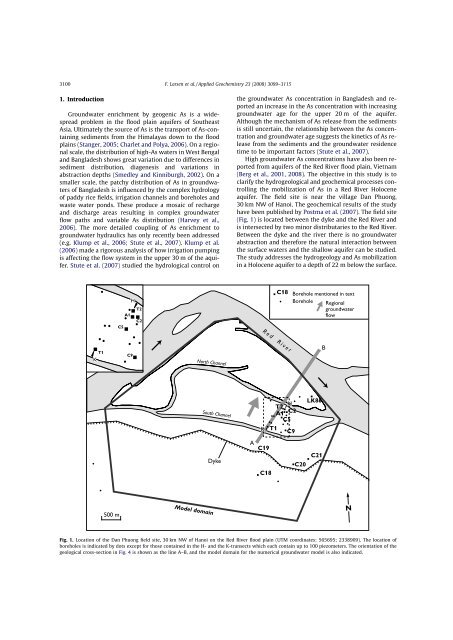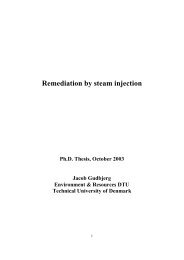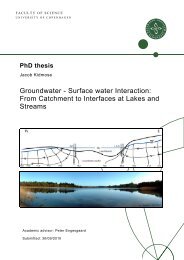Groundwater arsenic in the Red River delta, Vietnam ... - Fiva
Groundwater arsenic in the Red River delta, Vietnam ... - Fiva
Groundwater arsenic in the Red River delta, Vietnam ... - Fiva
You also want an ePaper? Increase the reach of your titles
YUMPU automatically turns print PDFs into web optimized ePapers that Google loves.
3100 F. Larsen et al. / Applied Geochemistry 23 (2008) 3099–3115<br />
1. Introduction<br />
<strong>Groundwater</strong> enrichment by geogenic As is a widespread<br />
problem <strong>in</strong> <strong>the</strong> flood pla<strong>in</strong> aquifers of Sou<strong>the</strong>ast<br />
Asia. Ultimately <strong>the</strong> source of As is <strong>the</strong> transport of As-conta<strong>in</strong><strong>in</strong>g<br />
sediments from <strong>the</strong> Himalayas down to <strong>the</strong> flood<br />
pla<strong>in</strong>s (Stanger, 2005; Charlet and Polya, 2006). On a regional<br />
scale, <strong>the</strong> distribution of high-As waters <strong>in</strong> West Bengal<br />
and Bangladesh shows great variation due to differences <strong>in</strong><br />
sediment distribution, diagenesis and variations <strong>in</strong><br />
abstraction depths (Smedley and K<strong>in</strong>niburgh, 2002). On a<br />
smaller scale, <strong>the</strong> patchy distribution of As <strong>in</strong> groundwaters<br />
of Bangladesh is <strong>in</strong>fluenced by <strong>the</strong> complex hydrology<br />
of paddy rice fields, irrigation channels and boreholes and<br />
waste water ponds. These produce a mosaic of recharge<br />
and discharge areas result<strong>in</strong>g <strong>in</strong> complex groundwater<br />
flow paths and variable As distribution (Harvey et al.,<br />
2006). The more detailed coupl<strong>in</strong>g of As enrichment to<br />
groundwater hydraulics has only recently been addressed<br />
(e.g. Klump et al., 2006; Stute et al., 2007). Klump et al.<br />
(2006) made a rigorous analysis of how irrigation pump<strong>in</strong>g<br />
is affect<strong>in</strong>g <strong>the</strong> flow system <strong>in</strong> <strong>the</strong> upper 30 m of <strong>the</strong> aquifer.<br />
Stute et al. (2007) studied <strong>the</strong> hydrological control on<br />
<strong>the</strong> groundwater As concentration <strong>in</strong> Bangladesh and reported<br />
an <strong>in</strong>crease <strong>in</strong> <strong>the</strong> As concentration with <strong>in</strong>creas<strong>in</strong>g<br />
groundwater age for <strong>the</strong> upper 20 m of <strong>the</strong> aquifer.<br />
Although <strong>the</strong> mechanism of As release from <strong>the</strong> sediments<br />
is still uncerta<strong>in</strong>, <strong>the</strong> relationship between <strong>the</strong> As concentration<br />
and groundwater age suggests <strong>the</strong> k<strong>in</strong>etics of As release<br />
from <strong>the</strong> sediments and <strong>the</strong> groundwater residence<br />
time to be important factors (Stute et al., 2007).<br />
High groundwater As concentrations have also been reported<br />
from aquifers of <strong>the</strong> <strong>Red</strong> <strong>River</strong> flood pla<strong>in</strong>, <strong>Vietnam</strong><br />
(Berg et al., 2001, 2008). The objective <strong>in</strong> this study is to<br />
clarify <strong>the</strong> hydrogeological and geochemical processes controll<strong>in</strong>g<br />
<strong>the</strong> mobilization of As <strong>in</strong> a <strong>Red</strong> <strong>River</strong> Holocene<br />
aquifer. The field site is near <strong>the</strong> village Dan Phuong,<br />
30 km NW of Hanoi. The geochemical results of <strong>the</strong> study<br />
have been published by Postma et al. (2007). The field site<br />
(Fig. 1) is located between <strong>the</strong> dyke and <strong>the</strong> <strong>Red</strong> <strong>River</strong> and<br />
is <strong>in</strong>tersected by two m<strong>in</strong>or distributaries to <strong>the</strong> <strong>Red</strong> <strong>River</strong>.<br />
Between <strong>the</strong> dyke and <strong>the</strong> river <strong>the</strong>re is no groundwater<br />
abstraction and <strong>the</strong>refore <strong>the</strong> natural <strong>in</strong>teraction between<br />
<strong>the</strong> surface waters and <strong>the</strong> shallow aquifer can be studied.<br />
The study addresses <strong>the</strong> hydrogeology and As mobilization<br />
<strong>in</strong> a Holocene aquifer to a depth of 22 m below <strong>the</strong> surface.<br />
Fig. 1. Location of <strong>the</strong> Dan Phuong field site, 30 km NW of Hanoi on <strong>the</strong> <strong>Red</strong> <strong>River</strong> flood pla<strong>in</strong> (UTM coord<strong>in</strong>ates: 565695; 2338909). The location of<br />
boreholes is <strong>in</strong>dicated by dots except for those conta<strong>in</strong>ed <strong>in</strong> <strong>the</strong> H- and <strong>the</strong> K-transects which each conta<strong>in</strong> up to 100 piezometers. The orientation of <strong>the</strong><br />
geological cross-section <strong>in</strong> Fig. 4 is shown as <strong>the</strong> l<strong>in</strong>e A–B, and <strong>the</strong> model doma<strong>in</strong> for <strong>the</strong> numerical groundwater model is also <strong>in</strong>dicated.





